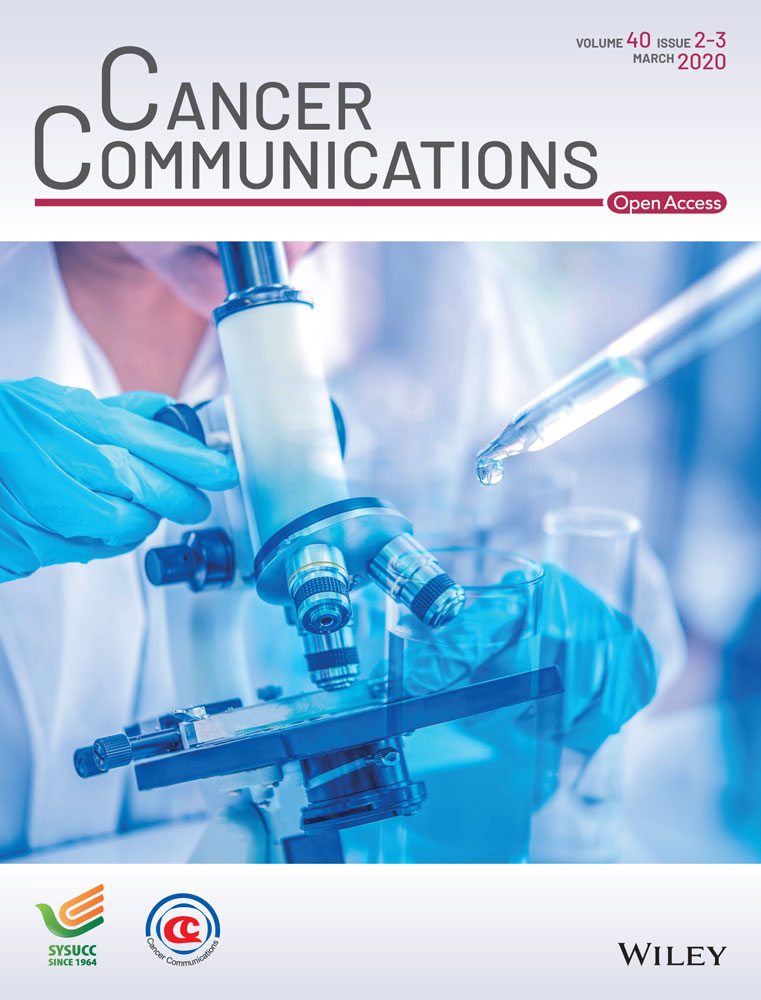Global and regional burdens of oral cancer from 1990 to 2017: Results from the global burden of disease study
Abstract
Background
Data on the incidence, mortality, and other burden of oral cancer as well as their secular trends are necessary to provide policy-makers with the information needed to allocate resources appropriately. The purpose of this study was to use the Global Burden of Disease (GBD) 2017 results to estimate the incidence, mortality, and disability-adjusted life years (DALYs) for oral cancer from 1990 to 2017.
Methods
We collected detailed data on oral cancer from 1990 to 2017 from the GBD 2017. The global incidence, mortality, and DALYs attributable to oral cancer as well as the corresponding age-standardized rates (ASRs) were calculated. The estimated annual percentage changes in the ASRs of incidence (ASRI) and mortality (ASRM) and age-standardized DALYs of oral cancer were also calculated according to regions and countries to quantify the secular trends in these rates.
Results
We tracked the incidence, mortality, and DALYs of oral cancer in 195 countries/territories over 28 years. Globally, the incidence, mortality, and DALYs of oral cancer increased by about 1.0-fold from 1990 to 2017. The ASRI of oral cancer showed a similar trend, increasing from 4.41 to 4.84 per 100,000 person-years during the study period. The ASRM remained approximately stable at about 2.4 per 100,000 from 1990 to 2017, as did the age-standardized DALYs, at about 64.0 per 100,000 person-years. ASRI was highest in Pakistan (27.03/100,000, 95% CI = 22.13-32.75/100,000), followed by Taiwan China, and lowest in Iraq (0.96/100,000, 95% CI = 0.86-1.06/100,000). ASRM was highest in Pakistan (16.85/100,000, 95% CI = 13.92-20.17/100,000) and lowest in Kuwait (0.51/100,000, 95% CI = 0.45-0.58/100,000).
Conclusions
The ASRI of oral cancer has increased slightly worldwide, while the ASRM and age-standardized DALY have remained stable. However, these characteristics vary between countries, suggesting that current prevention strategies should be reoriented, and much more targeted and specific strategies should be established in some countries to forestall the increase in oral cancer.
Abbreviations
-
- APC
-
- annual percentage change
-
- ASR
-
- age-standardized rate
-
- ASRI
-
- age-standardized rate of incidence
-
- ASRM
-
- age-standardized rate of mortality
-
- DALYs
-
- disability-adjusted life-years
-
- GBD
-
- Global Burden of Disease
-
- HDI
-
- Human Development Index
-
- SDI
-
- sociodemographic index
1 BACKGROUND
Oral cancer is the most common malignancy of the head and neck and an aggressive cancer that usually has a poor prognosis. There are more than 450,000 new cases of oral cancer each year worldwide, and only 40%–50% of these patients would survive 5 years since diagnosis [1, 2]. Moreover, recently there has been a dramatic increase in the incidence of oral cancer [3-6]. Although oral cancer is a significant global public health problem, data on its incidence, mortality, and disability-adjusted life-years (DALYs) are lacking, especially regarding specific data for each country or region. Comparing the oral cancer metrics among different countries or regions and their secular trends is valuable for determining how various health policies and screening protocols might affect the outcome of oral cancer. Moreover, reliable and precise reports on the epidemiologic patterns and secular trends in diseases in different geographic areas would provide policy-makers with the information needed to allocate resources appropriately. Continuous changes in the incidence or mortality of oral cancer have not been well analyzed. Previous studies reported the global incidence and mortality of oral cancer, but no specific data on its spatial distribution and secular trends were reported.
The Global Burden of Disease (GBD) study was a systematic effort to estimate the impact of diseases, injuries, and risk factors on health according to age, sex, and geography for time points from 1990 to 2017. The trends of age-standardized rates (ASRs) may serve as a good surrogate for the changing disease patterns in populations and hence represent a clue to changing risk factors. We can, therefore, evaluate the effectiveness of current prevention strategies by analyzing the ASRs with the aim of establishing more-targeted approaches for prevention. The estimated annual percentage change (APC), widely used to measure ASR trends over a specified time-period, employs the natural logarithm of the regression line fitting the rates. Clinically, lip cancer is a type of generalized oral cancer, and we thereby designated both lip cancer and oral cavity cancer in the GBD study as oral cancer. In the present study, we used the results of the GBD 2017 study (GBD 2017) [7, 8] to estimate the ASRs of incidence (ASRI) and mortality (ASRM) and age-standardized DALYs for oral cancer from 1990 to 2017 according to patient age, sex, country, region, and level of economic development.
2 MATERIALS AND METHODS
2.1 Data source
The latest version of the GBD 2017 results released at the end of November 2018 was used. We extracted data according to GBD's operation guide and set the options of disease type, age, and disease burden, without any inclusion/exclusion criteria. Data sources for the disease burdens of lip cancer and oral cavity cancer (carcinoma occurring in the mucosa of the oral cavity) were explored using the Global Health Data Exchange (GHDx) online data source query tool (http://ghdx.healthdata.org/gbd-results-tool). We obtained data on the incidence, mortality, and DALYs of oral cancer, and calculated ASRs from 1990 to 2017 according to sex, 21 regions, and 195 countries/territories. The 195 countries/territories were divided into the following 5 categories based on the sociodemographic index (SDI) in 2017: low, low-middle, middle, high-middle, and high SDI. The official GBD study website provides a detailed description of the general methods applied for GBD 2017 (http://ghdx.healthdata.org/gbd-2017) and the SDI values from 1990 to 2017 at global, regional, and national levels. Meanwhile, the human development index (HDI) values of all nations were collected from the World Bank. We also analyzed the global trends in oral cancer according to the following age stratification of GBD 2017: 10-14, 15-19, 20-24, 25-29, 30-34, 35-39, 40-44, 45-49, 50-54, 55-59, 60-64, 65-69, 70-74, 75-79, and ≥ 80 years.
2.2 Statistical methods
Estimated APCs were calculated in accordance with the study of Liu et al. [9], that is, y = a + bx + e, where y refers to ln(ASR) and x is the calendar year. Estimated APC is calculated as 100 × (exp(b) – 1), and its 95% confidence interval (CI) can also be obtained from the linear regression model. The ASR is considered to be exhibiting an increasing trend if the estimated APC and the lower limit of the 95% CI are both > 0, and a decreasing trend if the estimated APC and the upper limit of the 95% CI are both < 0; otherwise the ASR is considered to be stable. In addition, to identify the factors influencing the estimated APCs, we evaluated the associations between the estimated APC and ASR in 1990 and the HDI for 2017 at the national level. The ASR in 1990 reflects the disease reservoir at baseline, and the HDI for 2017 can serve as a surrogate for the level and availability of health care in each country [9]. The R program (R x3.5.1) (https://www.r-project.org/) was used for statistical analyses.
3 RESULTS
3.1 Incidence of oral cancer
The estimated incident cases of oral cancer globally increased from 185,976 cases (95% CI = 180,307-191,929 cases) in 1990 to 389,760 cases (95% CI = 374,456-404,404 cases) in 2017, corresponding to an increase of 109.6% (95% CI = 97.2%-120.6%). The increase in incident cases was largest in the United Arab Emirates (877.4%, 95% CI = 517.6%-1404.4%), followed by Qatar and Taiwan China, while the largest decrease in incident cases occurred in Croatia (Figure 1A). The ASRI of oral cancer showed a similar trend, increasing from 4.41/100,000 (95% CI = 4.28-4.55/100,000) to 4.84/100,000 (95% CI = 4.65-5.02/100,000) during the study period. In 2017, the ASRI was highest in Pakistan (27.03/100,000, 95% CI = 22.13-32.75/100,000), followed by Taiwan China, and lowest in Iraq (0.96/100,000, 95% CI = 0.86-1.06/100,000). India, the country with the second-largest population worldwide, also had a high ASRI (9.32/100,000, 95% CI = 8.60-9.91/100,000), while Mainland China, the most-populous country, had a lower ASRI (2.44/100,000, 95% CI = 2.30-2.57/100,000) than the world average (Figure 1B; Table S1).
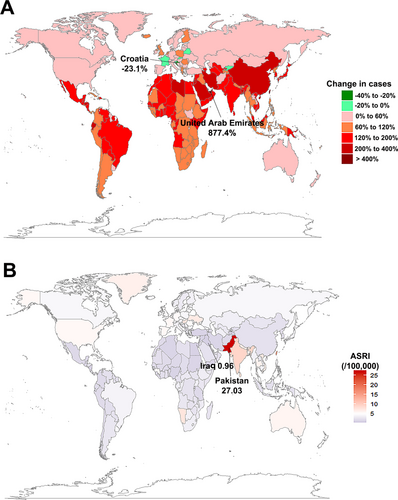
In terms of geographic regions, the ASRI was highest in South Asia (10.71/100,000, 95% CI = 9.92-11.50/100,000) in 2017 and lowest in North Africa and the Middle East (1.48/100,000, 95% CI = 1.41-1.56/100,000). Overall, the incidence increased in all regions from 1990 to 2017, with the increase being largest in South Asia and East Asia (Figure 2A). However, the ASRI varied widely among regions over the past 30 years (Figure 2B). The incident cases showed an increasing trend in all SDI quintiles, while ASRI was also increased in all SDI quintiles except for countries with a high SDI. The ASRI was highest in low-middle-SDI countries (7.45/100,000, 95% CI = 6.81-8.18/100,000) and low-SDI countries (5.94/100,000, 95% CI = 5.52- 6.36/100,000), while middle-SDI countries had the largest increase between 1990 and 2017, from 3.36/100,000 (95% CI = 3.22-3.48/100,000) to 4.20/100,000 (95% CI = 3.97-4.38/100,000) (Figure 2C and D; Table 1). The incidence of oral cancer increased with age and was significantly higher in males than in females (Figure 2E).
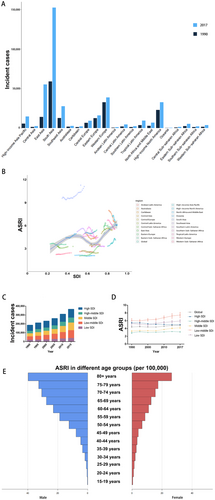
| ASRI (/100,000) | ||
|---|---|---|
| Location | Estimate | 95% CI |
| Global | 4.84 | 4.65–5.02 |
| Region | ||
| South Asia | 10.71 | 9.92–11.50 |
| Australasia | 5.91 | 5.24–6.64 |
| High–income North America | 5.59 | 5.39–5.79 |
| Eastern Europe | 4.96 | 4.76–5.19 |
| Western Europe | 4.90 | 4.67–5.16 |
| Central Europe | 4.74 | 4.56–4.95 |
| Southeast Asia | 4.65 | 4.36–4.94 |
| Oceania | 4.35 | 3.67–5.68 |
| Caribbean | 4.09 | 3.77–4.43 |
| Tropical Latin America | 3.96 | 3.81–4.10 |
| Southern Sub-Saharan Africa | 3.68 | 3.45–3.92 |
| High-income Asia Pacific | 3.50 | 3.30–3.75 |
| Eastern Sub-Saharan Africa | 2.97 | 2.74–3.21 |
| Central Asia | 2.96 | 2.80–3.13 |
| Southern Latin America | 2.72 | 2.46–3.00 |
| East Asia | 2.71 | 2.57–2.83 |
| Central Sub-Saharan Africa | 2.69 | 2.34–3.05 |
| Andean Latin America | 1.96 | 1.76–2.18 |
| Central Latin America | 1.89 | 1.80–1.97 |
| Western Sub-Saharan Africa | 1.85 | 1.62–2.10 |
| North Africa and the Middle East | 1.48 | 1.41–1.56 |
| SDI category | ||
| Low-middle-SDI | 7.45 | 6.81–8.18 |
| Low-SDI | 5.94 | 5.52–6.36 |
| High-SDI | 5.00 | 4.85–5.14 |
| Middle-SDI | 4.20 | 3.97–4.38 |
| High-middle-SDI | 3.14 | 3.03–3.26 |
- The global ASRI of oral cancer was 4.84/100,000; the region with the highest ASRI was South Asia, and the regions with the lowest ASRI were North Africa and the Middle East; low-middle-SDI countries had the highest ASRI, whereas high-middle-SDI countries had the lowest ASRI. ASRI: age-standardized rate of incidence. SDI: socio-demographic index.
3.2 Mortality of oral cancer
Oral cancer caused 193,696 deaths (95% CI = 184,723-201,641) globally in 2017, which represented a 98.7% (95% CI = 84.1%-110.6%) increase from the 97,492 deaths (95% CI = 93,861-101,580) in 1990. The increase was largest in the United Arab Emirates (729.7%, 95% CI = 415.0%-1190.8%), followed by Taiwan China and Qatar, while the largest decrease occurred in Croatia (Figure 3A). Globally, the oral cancer age-standardized rate of mortality (ASRM) remained essentially stable at about 2.42/100,000 (95% CI = 2.31-2.52/100,000) from 1990 to 2017. The ASRM was highest in Pakistan (16.85/100,000, 95% CI = 13.92-20.17/100,000) in 2017 and was also high in India (6.13/100,000, 95% CI = 5.63-6.52/100,000), while it was low in Mainland China (1.09/100,000, 95% CI = 1.03-1.14/100,000), and lowest in Kuwait (0.51/100,000, 95% CI = 0.45-0.58/100,000) (Figure 3B, Table S2).
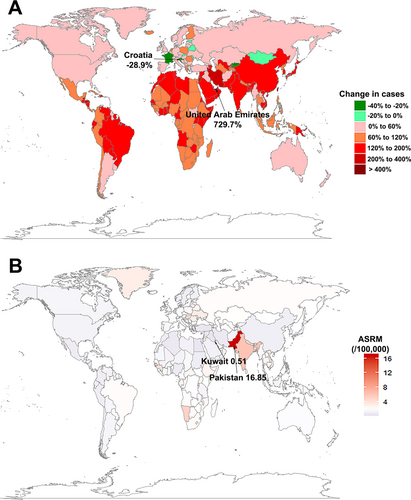
In terms of geographic regions, the ASRM was highest in South Asia (6.95/100,000, 95% CI = 6.41-7.45/100,000) in 2017 and lowest in North Africa and the Middle East (0.78/100,000, 95% CI = 0.75-0.82/100,000). Overall, even though the ASRMs were decreasing in some regions, the death cases increased in all regions from 1990 to 2017, most significantly in South Asia and East Asia (Figure 4A and B). The ASRM increased in low-, low-middle-, and middle-SDI countries from 1990 to 2017, but decreased in high- and high-middle-SDI countries. However, the death cases showed an increasing trend across all SDI quintiles (Figure 4C and D). The ASRM was highest in low-middle-SDI countries (4.70/100,000, 95% CI = 4.31 - 5.13/100,000) and low-SDI countries (4.34/100,000, 95% CI = 4.01 - 4.64/100,000) (Table 2). The age and sex trends of ASRM were similar to those of ASRI, being higher in males and increased with age (Figure 4E).
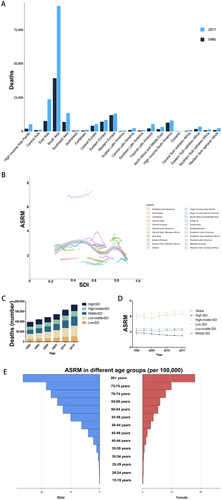
| ASRM (/100,000) | ||
|---|---|---|
| Location | Estimate | 95% CI |
| Global | 2.42 | 2.31–2.52 |
| Region | ||
| South Asia | 6.95 | 6.41–7.45 |
| Central Europe | 2.70 | 2.60–2.81 |
| Oceania | 2.68 | 2.29–3.50 |
| Eastern Europe | 2.51 | 2.43–2.61 |
| Southern Sub-Saharan Africa | 2.44 | 2.29–2.60 |
| Southeast Asia | 2.44 | 2.30–2.58 |
| Caribbean | 2.29 | 2.12–2.47 |
| Tropical Latin America | 2.27 | 2.19–2.34 |
| Eastern Sub-Saharan Africa | 2.23 | 2.04–2.42 |
| Central Sub-Saharan Africa | 2.06 | 1.79–2.34 |
| Central Asia | 1.73 | 1.64–1.82 |
| Australasia | 1.68 | 1.52–1.85 |
| Western Europe | 1.53 | 1.46–1.60 |
| Western Sub-Saharan Africa | 1.31 | 1.15–1.49 |
| High-income North America | 1.30 | 1.26–1.34 |
| Southern Latin America | 1.28 | 1.17–1.41 |
| East Asia | 1.17 | 1.11–1.23 |
| High-income Asia Pacific | 1.10 | 1.06–1.16 |
| Andean Latin America | 1.07 | 0.97–1.18 |
| Central Latin America | 1.01 | 0.97–1.05 |
| North Africa and the Middle East | 0.78 | 0.75–0.82 |
| SDI category | ||
| Low-middle- SDI | 4.70 | 4.31–5.13 |
| Low-SDI | 4.34 | 4.01–4.64 |
| Middle-SDI | 2.26 | 2.14–2.36 |
| High-middle-SDI | 1.51 | 1.46–1.56 |
| High-SDI | 1.50 | 1.46–1.54 |
- The global ASRM of oral cancer was 2.42/100,000; the region with the highest ASRM was South Asia, and the regions with the lowest ASRM were North Africa and the Middle East; low-middle-SDI regions had the highest ASRM, whereas high-SDI regions had the lowest ASRM. ASRM: age-standardized rate of mortality. SDI: socio-demographic index.
3.3 Oral cancer disability-adjusted life years
Oral cancer DALYs increased by 87.1% (95% CI = 71.9%-99.5%) during the study period, from 2,807,879 years (95% CI = 2,698,338-2,938,439 years) in 1990 to 5,253,881 years (95% CI = 4,977,013-5,497,618 years) in 2017. The increase was largest in the United Arab Emirates (738.8%, 95% CI = 418.0%-1249.4%), followed by Qatar and Taiwan China, while it decreased most significantly in Croatia (Figure 5A). Globally, the age-standardized DALY of oral cancer remained essentially stable from 63.86/100,000 person-years in 1990 to 64.23/100,000 person-years in 2017. The age-standardized DALY in 2017 was highest in Pakistan (467.42/100,000 person-years, 95% CI = 385.70-564.61/100,000 person-years) and was also high in India (159.09/100,000 person-years, 95% CI = 145.65-169.45/100,000 person-years), but was lowest in Kuwait (11.63/100,000 person-years, 95% CI = 10.32-13.47/100,000 person-years) (Figure 5B, Table S3).
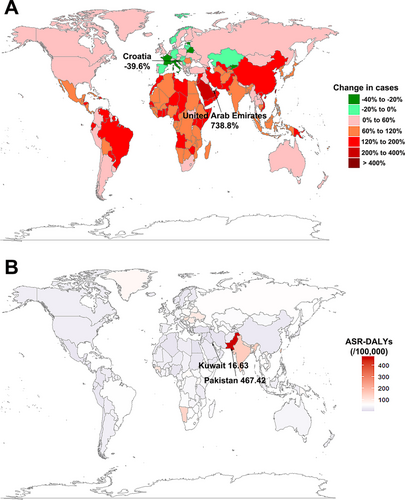
In terms of geographic regions, the age-standardized DALY in 2017 was highest in South Asia (180.83/100,000 person-years, 95% CI = 165.54-195.14/100,000 person-years) and lowest in North Africa and the Middle East (19.02/100,000 person-years, 95% CI = 18.15-20.0/2100,000 person-years). Overall, even though the age-standardized DALYs were decreasing in some regions, the DALYs increased in all regions from 1990 to 2017, by the most in South Asia and East Asia (Figure 6A and B). From 1990 to 2017, the age-standardized DALYs decreased or remained unchanged in all SDI quintiles except in low-middle-SDI countries, while DALYs increased in all SDI quintiles (Figure 6C and D). The age-standardized DALY was highest in low-middle-SDI (125.94/100,000 person-years, 95% CI = 114.22-138.75/100,000 person-years) and low-SDI countries (99.61/100,000 person-years, 95% CI = 92.48-106.91/100,000 person-years) countries, and lowest in high-SDI countries (38.00/100,000 person-years, 95% CI = 36.79-39.33/100,000 person-years) (Table 3). In terms of the age distribution, because the calculation of DALYs contains a time factor, the trend of age-standardized DALYs differed from those of ASRI and ASRM. The age-standardized DALY increased with age in patients younger than 65 years, and decreased with age or remained constant in those ≥ 65 years old. The age-standardized DALY was higher in males than in females (Figure 6E).
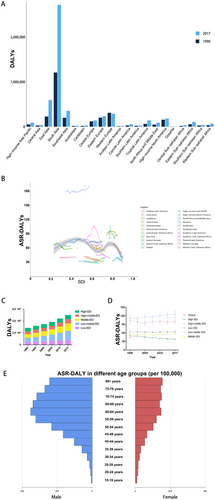
| Age-standardized DALY (/100,000) | ||
|---|---|---|
| Location | Estimate | 95% CI |
| Global | 64.23 | 60.86–67.20 |
| Region | ||
| South Asia | 180.83 | 165.54–195.14 |
| Central Europe | 74.22 | 71.03–77.43 |
| Eastern Europe | 73.14 | 70.38–76.17 |
| Oceania | 69.01 | 56.69–96.47 |
| Southern Sub-Saharan Africa | 62.74 | 58.35–67.47 |
| Tropical Latin America | 57.34 | 55.18–59.39 |
| Southeast Asia | 55.91 | 52.51–59.59 |
| Eastern Sub-Saharan Africa | 54.45 | 49.93–59.22 |
| Caribbean | 53.72 | 49.54–58.17 |
| Central Sub-Saharan Africa | 50.43 | 43.68–57.17 |
| Central Asia | 45.14 | 42.67–47.56 |
| Australasia | 41.34 | 36.99–46.01 |
| Western Europe | 38.77 | 36.80–40.92 |
| High-income North America | 32.06 | 30.70–33.43 |
| Western Sub-Saharan Africa | 31.48 | 27.50–35.77 |
| Southern Latin America | 30.72 | 27.78–33.84 |
| East Asia | 28.17 | 26.69–29.54 |
| Andean Latin America | 25.10 | 22.44–27.80 |
| High-income Asia Pacific | 24.40 | 23.31–25.95 |
| Central Latin America | 23.13 | 22.12–24.14 |
| North Africa and the Middle East | 19.02 | 18.15–20.02 |
| SDI category | ||
| Low-middle-SDI | 125.94 | 114.22–138.75 |
| Low-SDI | 99.61 | 92.48–106.91 |
| Middle-SDI | 57.09 | 53.35–59.96 |
| High-middle-SDI | 38.63 | 37.28–39.94 |
| High-SDI | 38.00 | 36.79–39.33 |
- The global age-standardized DALY of oral cancer was 64.23/100,000; the region with the highest age-standardized DALY was South Asia, and the regions with the lowest age-standardized DALY were North Africa and the Middle East; low-middle-SDI regions had the highest age-standardized DALY, whereas high-SDI regions had the lowest age-standardized DALY. DALY: disability-adjusted life-years. SDI: socio-demographic index.
3.4 Estimated annual percentage changes in incidence, mortality, and disability-adjusted life years
Scatter plots were plotted to investigate whether the linearity assumption holds. The results partly confirmed the linear relationship between the ln(ASR) and the calendar year in regions (adjusted r2 = 0.59 ± 0.030) and in countries/territories (adjusted r2 = 0.57 ± 0.03). The estimated APCs were 0.26% (95% CI = 0.16% to 0.37%) in ASRI (Figure 7A), –0.01% (95% CI = –0.08% to 0.05%) in ASRM (Figure 7B), and –0.08% (95% CI = –0.14% to –0.01%) in age-standardized DALYs of oral cancer globally (Figure 7C), and all were highest in East Asia. There were significant negative associations between the HDI for 2017 and the estimated APCs in the ASRI (ρ = –0.178, P = 0.016), ASRM (ρ = –0.312, P < 0.001), and age-standardized DALYs of oral cancer (ρ = –0.319, P < 0.001) (Figure 8). The HDI for 2017 may serve as an alternative indicator of the level and availability of health care in each country. It can be argued that from 1990 to 2017, the ASRs of the incidence and mortality, and age-standardized DALYs of oral cancer were decreasing in countries with higher HDI. However, in the cluster analysis of estimated APC, we found that both Mainland China and Taiwan China were in the first echelon of incidence and mortality increases (Figures S1 and S2).
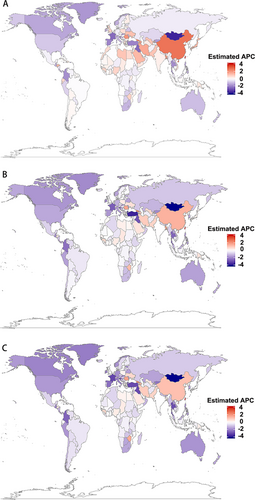
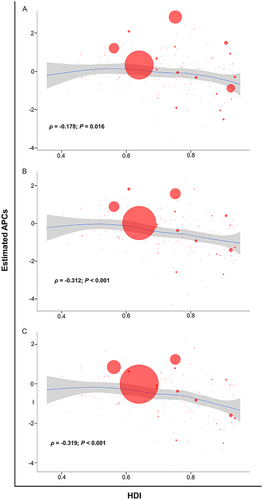
4 DISCUSSION
By analyzing data from the GBD database, the present study estimated the incidence, mortality, and DALYs of oral cancer in 195 countries/territories and 21 regions from 1990 to 2017, and elucidated the differences in ASRI, ASRM, and age-standardized DALYs among different countries or regions and how these disease burdens changed over these 28 years. The results of this study can help decision-makers in different countries to understand the disease burden of oral cancer in their own regions, as well as other countries or regions, so that they can learn from the advanced experience of countries or regions with good disease burden control.
The present study demonstrated that the incidence, mortality, and DALYs of oral cancer were steadily increasing around the world. Globally, the ASRI was also significantly increased, whereas ASRM and age-standardized DALYs remained mostly unchanged or were significantly reduced. However, the data vary among regions and countries. At the national level, some countries (e.g., the United Arab Emirates and Qatar) experienced significant increases in the incidence and mortality as a result of population growth [10-12]. Pakistan has the highest ASRI, ASRM, and ASR-DALY of oral cancer, which may be partly explained by its large population. Its neighbor India has a similar situation. This may also be related to the dietary habits, oral health, and other behaviors of the citizens of these countries. For example, the citizens of many countries in South and Southeast Asia, as well as those in Taiwan, Hunan, Hainan, and other provinces of China have a long history of chewing betel nuts. These countries and regions should pay attention to the oral health and dietary habits of their citizens at the national level in order to effectively reduce the incidence of oral cancer [13-16].
At the regional level, there was a large difference in the disease burden of oral cancer in different regions. Asia (especially South and Southeast Asia) has been greatly affected by oral cancer. South Asia has the highest incidence, mortality, DALYs. The present study also demonstrated that the incidence of oral cancer was higher in high-, middle-, and low-middle-SDI countries but lower in low- and high-middle-SDI countries. However, low-middle- and middle-SDI countries had the highest mortality and DALYs. In terms of the ASRs of incidence, mortality, and age-standardized DALYs, only low-middle- and low-SDI countries showed increasing trends, while other SDI countries showed decreasing trends. These results are consistent with those of recent studies that have analyzed other cancer databases [17, 18]. Moreover, the cure rate of oral cancer was significantly higher in high-SDI countries than in other countries [19, 20]. The present study demonstrated that, with the same ASRI, the ASRM and age-standardized DALYs of oral cancer patients in developed countries or regions were generally lower than those in developing countries. This may be possibly due to that developed countries have more manpower and financial resources to invest in basic oral health care to increase the early detection rate of oral cancer and improve treatment outcomes of this disease. Meanwhile, residents in developed countries pay more attention to oral health, and oral cancer may be diagnosed and treated early. On the other hand, oral cancer patients need effective multimodality therapy including surgery, radiotherapy, chemotherapy, targeted therapy, and other therapies to achieve better prognosis [21, 22], which can be easier to implement in economically developed regions.
In the present study, we identified trends in the burden of oral cancer. The estimated APC in the ASRI was ascending globally, indicating that the incidence of oral cancer is still increasing worldwide. Mainland China and Taiwan China had the highest estimated APCs in ASRI, suggesting that the government should invest more money and health care resources to prevent and treat oral cancer. The estimated APCs in the ASRM and age-standardized DALYs were declining globally, indicating that the mortality of oral cancer is decreasing, the cure rate of oral cancer has increased, and the survival of patients has thereby been prolonged. At the same time, we cannot ignore that the ASRM and ASR-DLAY of oral cancer were still increasing in some countries, almost all of which are developing countries.
The data obtained in the GBD study address gaps in the knowledge of disease burden, but some limitations of using these data in the present study should be noted. First, the accuracy and robustness of GBD estimates depend to a large extent on the quality and quantity of data used in the modeling. For example, it was not possible to statistically analyze lip cancer and oral cancer separately. Second, the roles of specific risk factors for oral cancer were not estimated—such information could help to explain geographic and temporal patterns in the disease burden [23]. Last but not least, only the burden of oral cancer in each country or region was obtained, and the corresponding causes cannot be determined.
5 CONCLUSIONS
The ASRI of oral cancer has increased slightly worldwide, while the ASRM and age-standardized DALYs have remained generally stable or have decreased slightly. However, there are variations among countries that need to be considered. Current prevention strategies should be reoriented, and more targeted and specific strategies should be established in countries with high ASRI, ASRM, or age-standardized DALYs to forestall the increase in the disease burden of oral cancer.
ETHICS APPROVAL AND CONSENT TO PARTICIPATE
Not applicable.
CONSENT FOR PUBLICATION
Not applicable.
COMPETING INTERESTS
The authors declared that they have no competing interests.
FUNDING
This study was supported by The Interdisciplinary Program of Shanghai Jiao Tong University (ZH2018QNA08); (Zhang Zhiyuan) Academician Workstation Scientific Research Fund (2019); The SHIPM-mu fund No. JC201902 from the Shanghai Institute of Precision Medicine, Ninth People’s Hospital Shanghai Jiao Tong University School of Medicine; The Shanghai Anticancer Association Eyas Project (SACA-CY1B06); the National Social Science Foundation of China (No.16BGL183).
ACKNOWLEDGMENTS
We appreciate the works by the Global Burden of Disease 2017 study collaborators. We thank all the individuals who contributed to the Global Burden of Disease 2017 study for their extensive support in finding, cataloging, and analyzing data and facilitating communication between and among team members.
AUTHORS’ CONTRIBUTIONS
Study design: ZHR, JL. Data collection: CYH, HRH, YJL. Data analyses: CYH, ZHR. Results interpretations: All authors. Manuscript writing: ZHR, CYH. Manuscript proofing: JL, YJL.
AVAILABILITY OF DATA AND MATERIALS
The datasets used and/or analyzed during the current study are available from the corresponding author on reasonable request.



